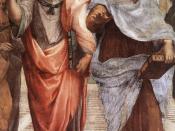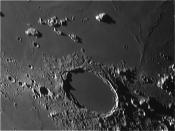Raffaello Santi, known as Raphael, was born in 1483 (Beck). He painted The School of Athens, the study of philosophy, in 1509. This painting truly was the quintessential depiction of the Renaissance.
This painting contains many Greek philosophers arranged in a large architectural setting. They are presumably talking to each other, discussing theories or mathematical queries. This is symbolic of the philosophic thinking and the search for truth that was apparent during both the Renaissance and Greek antiquity. Many of the philosophers have double identities with contemporary artists. This demonstrates the Renaissance value of antiquity. The central figures are Plato and Aristotle (Macedon). Plato is represented in the likeness of Leonardo di Vinci. Also, Heraclitus, seated in the front, and slightly left of center, represents the brooding sentiment of Michaelangelo.
The philosophers are split into the left side and right, apparently by their beliefs. Those on the left root their philosophies in universals and those on the right on particulars (Claybourn).
Plato, left, points upward in reference to his beliefs that God and absolutes were the grounding for all things, while Aristotle, left, points to the earth, demonstrating his belief that the earthly particulars will help you build a relationship with Something Greater (Claybourn). Leonardo di Vinci's depiction as Plato is counterintuitive because he was actually more of a humanist rather than focusing his efforts on the divine.
Raphael portrays himself in the painting, thus trying to place himself as a great mind, he stands next to contemporary painter Sodoma (Hubert). Donato Bramante represents the face of Euclid, as he draws his triangle. The other philosophers in this painting, roughly from left to right are Zeno, Epicurus, Averroes, Pythagoras, Alcibiades, Xenophon, Aeschines, Paremenides, Socrates, Diogenes, Zoroaster, and bottomless. Raphael's extreme command on the subject matter is apparent in the...


